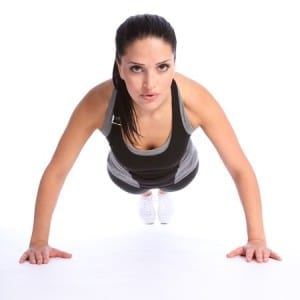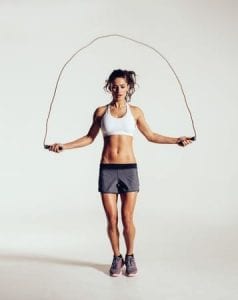 Before trying Tabata for the first time, I searched online for a list of Tabata exercises for beginners and couldn’t find one.
Before trying Tabata for the first time, I searched online for a list of Tabata exercises for beginners and couldn’t find one.
There were plenty of Tabata exercises, but most were advanced level, so way beyond what I could realistically manage without injuring myself.
That was several years ago, and there’s still not all that much information available on Tabata workouts for novices. So I decided to make this top 10 Tabata exercises for beginners list.
If you’re new to Tabata, they’re a good starting point. If you already include Tabata exercises in your workout routine, do advanced versions of the moves or put in extra effort.
I will also include a great Tabata workout for beginners that I recently came across on YouTube, which you may like to try.
Table of Contents
Tabata Exercises Overview
If you’re like me, you lead a busy life and always looking for shortcuts and quick fixes to save time. An area that had been difficult to cut corners with is physical fitness.
That was because we believed that for exercise to be effective, we had to do it for a minimum of 20 minutes non-stop, at least three times a week.
Longer, more frequent workouts were considered even better. Then along came Tabata training, the 4-minute workout, which flipped that notion on its head.
If this article is your introduction to Tabata exercises, you may be skeptical that a 4-minute workout could be of any benefit. With so many whacky exercise programs out there that don’t work, I wouldn’t blame you.
The thing is, Tabata does work, and it works very well. Each session takes just four minutes to complete, making it a boon for busy people who cannot spend hours exercising each week.
Keep in mind, though, that you will also need to take the time to warm up before and cool down after doing Tabata exercises.
I typically do a 3 or 4-minute Warm-Up that usually consists of walking on the spot while swinging my arms, progressing to jogging, Lunges, plus some gentle stretches. After my workout, I do a few minutes of light jogging on the spot, slowing to a walk. I then finish off with more stretches.
What Does a Typical Tabata Workout Consist Of?
Comprising High Intensity Interval Training (HIIT), Tabata is the creation of Dr. Izumi Tabata, a former hockey coach  who helped develop and refine the system in the 1990s.
who helped develop and refine the system in the 1990s.
Workouts are broken down into 20 seconds of HIIT, during which the exerciser goes as hard and fast as they can, followed by a 10 second rest period.
This is repeated for the session’s duration, which lasts for 4 minutes.
You can do the same exercise from the start of the workout until the end, or choose up to eight different exercises.
Tabata training sounds very easy seeing it on paper, but if you do it as it’s meant to be done, believe me, it is anything but.
You will sweat and be out of breath, and a couple of minutes into the workout, lactic acid will begin building up in your muscles. This is due to the fast pace of the activity and the short time you have to rest between sets.
By now, you are probably wondering why anyone would put themselves through that, and it’s a fair question. For me, initially, it was the challenge of sticking with something that I thought was going to kill me the first few times I did it.
I kept reminding myself that it was only for four minutes. It did become more manageable, and while I haven’t gone on to do longer sets as some people do, these days, I look forward to my thrice weekly Tabata workouts.
How many calories will I burn?
The number of calories you burn will depend on factors including your gender, weight, the exercises you do, and how much effort you exert.
The average person will burn around 67 calories every 4 minutes they do Tabata. That equates to a whopping 1,000 calories per hour!
Following each session, your metabolic rate will be higher, and you will continue to burn additional calories for hours after you finish exercising.
If you’d like to find out more about Tabata training, click the following link: Tabata Training, the 4 Minute Workout that Works.
Tabata Exercises for Beginners
You can incorporate an almost limitless range of exercises into Tabata workouts.
In fact, you could work out for years and not do the same workout twice. This makes it a great form of exercise for those bored by repetition.
When you are starting, don’t choose exercises beyond your capability. Do so, and an injury is almost inevitable.
Following are some of my favorite beginner Tabata exercises. If you find them too difficult, modify them. For example, do Bent-Knee Push-Ups rather than regular ones. Lift your opposite arm and leg (one at a time) when doing Superman, rather than lifting all four limbs simultaneously.
N.B.: While the exercises listed below are modifiable for beginners if you haven’t exercised before, I recommend putting Tabata on hold until you have attained a certain degree of muscular strength and cardiovascular fitness.
Burpees
Burpees are exceptionally effective. They are also one of the toughest Tabata exercises for beginners, so be forewarned.
Benefits:
Benefits from regularly including Burpees in your exercise routine include improved agility, strength, endurance, and power.
Method:
1. Standing with your feet approximately hip-width apart and your core engaged, perform a low squat, aiming for a position that brings your knees close to your chest.
2. Place your hands securely on the floor in front of you, then quickly kick back with your feet. This movement will put you in a Push-Up position.
3. Quickly push back up off the ground, bringing your feet and legs forward to take yourself back into a squat position.
4. Immediately jump up into the air as high as you can, with your arms extended upwards and slightly outwards. Your feet will then land on the ground, bringing you back to your starting position.
Repeat the exercise as many times as you can for 20 seconds.
Click here for a video demonstration of Burpees
Jumping Lunges
The Jumping Lunge is another one of the toughest beginner Tabata exercises. It is harder to do than a traditional lunge, and it requires additional strength and  power.
power.
Benefits:
It targets the hamstrings, quads, and glutes, and improves cardiovascular fitness.
Method:
1. Start by standing upright with your feet together, your shoulders back, hands on your hips, and looking straight ahead.
2. Engage your core, then lunge forward with your right foot, your right knee bent at an angle of 90 degrees. At this point, your torso should be vertical to the floor.
3. Jump up high, and while your feet are off the ground, switch the position of your legs so your left foot is at the front, before landing softly to absorb the impact.
Repeat the sequence, alternating legs and doing as many reps as you can in 20 seconds.
Click here for a video demonstration of Jumping Lunges
Jump Rope
Jump ropes are portable and inexpensive.
Before you start, find a free space that measures 4′ by 6′ or greater, with an overhead clearance of at least 10″.
If possible, exercise on a wooden floor or a piece of plywood. If you have no choice but to jump rope on grass, carpet, or asphalt, an exercise mat will help you avoid injury by absorbing the impact as you land.
While carpet does provide a cushioning effect, it is still important to use a mat when exercising on it. This is because your shoes could stick to it, and as a result, you could twist your knee or ankle.
It’s also important that you wear a supportive pair of sports shoes when jumping rope.
Benefits:
They deliver a great leg and cardio workout and sculpt the shoulders, chest, and arms.
Method:
1. Place one end of the rope in either hand and stand on the rope. Shorten it if necessary so that the handles are about in line with your armpits.
2. Standing up straight with your core engaged, turn the rope, keeping your elbows close to your sides, and making sure the movement comes from your wrists and forearms. Jump 1 to 2 inches off the floor, landing on the balls of your feet.
Do this continuously for 20 seconds.
Click here for a Jump Rope video demonstration
Mountain Climbers
Done slowly, Mountain Climbers is a highly effective Tabata exercise for beginners. Increasing the speed of the movements will make it suitable for advanced-level exercisers.
Benefits:
Mountain Climbers increase the heart rate and improve leg strength and endurance.
Method:
1. Starting in an elevated Push-Up position with your core engaged, jump, drawing your right knee up towards your chest, pushing your left leg back to extend it behind you with your foot resting on the floor. Throughout this movement, your hips should remain level, not elevated.
2. Alternate the movement so that one foot is always coming towards your chest as the other is going back behind you to land on the floor.
Do as many reps as you can in 20 seconds.
Click here for a video demonstration of Mountain Climbers
Plank Jacks
Plank Jacks are simple to do but can be very challenging initially.
Benefits:
They target the core and provide a good cardiovascular workout.
Method:
1. Assume a Plank position, with your weight supported on your forearms and balls of your feet, your hands in loose fists. Brace your core muscles and keep your back straight and your feet together throughout the exercise.
2. Jump your feet out to either side, so your legs shape the letter Y before jumping your feet back to their starting position.
Repeat these movements as many times as you can in 20 seconds.
Click here for a video demonstration of Plank Jacks
Push-Ups
Push-ups are simple, effective, and very challenging to start, so do the modified version if you can’t manage the standard ones initially.
Benefits:
Push-Ups are excellent for toning and strengthening the entire upper body.
Method:
1. Get into a Plank position, your hands slightly wider than shoulder-width apart, your feet close together. Straighten your back and brace your core muscles.
2. Bend your elbows out to the sides as you lower your body towards the floor in a straight horizontal line, stopping when your nose touches the floor.
3. Straighten your arms, lifting your body back to its starting position.
Do as many repetitions as you can in 20 seconds.
Click here for a video demonstration of Push-Ups
Superman
Superman is a simple floor exercise that is more challenging than it sounds and looks.
Benefits:
It does a great job of strengthening the back and working the core, glutes, and hamstrings.
Method:
1. Lie face down on the floor, keeping your spine in a neutral position. Reach your arms forward, your legs straight out behind you, and brace your core muscles.
2. Keeping your chest glued to the floor, lift your hands and feet upwards, squeezing your glutes and shoulders before lowering your hands and feet to their starting position.
Do as many reps as you can in 20 seconds.
Click here for a video demonstration of Superman
Squat Jacks
Squat Jacks combine two of the most popular bodyweight exercises, these being the Squat and the Jumping Jack.
Benefits:
Providing a great workout for the legs and cardiovascular system, Squat Jacks are well worth including in your arsenal of Tabata exercises.
Method:
1. Engage your core and with your shoulders back, hands together in front of you, and looking straight ahead, squat with your feet positioned at least shoulder-width apart, your hands together in front of you.
2. Keeping your butt lined up with your knees throughout, jump your feet inwards, allowing them to meet in the middle, then jump outwards, bringing your feet back to their starting position.
Repeat as many times as you can in 20 seconds.
Click here for a video demonstration of Squat Jacks
Tabata Sprints
Benefits:
Another one of the most challenging Tabata exercises for beginners is the Tabata Sprint. They can be done on a treadmill or  outdoors.
outdoors.
Start with a 20-second sprint followed by 10 seconds of jogging, walking, or rest.
Benefits:
They tone the entire body and provide an excellent cardio workout.
Method:
1. Stand with your legs slightly bent, your chest held high, back straight, shoulders relaxed, and your eyes looking straight ahead.
2. With your elbows at a 45-degree angle, sprint forward, swinging your arms to increase your speed. Go as far and as fast as you can for 20 seconds.
Click here for a video demonstration of Tabata Sprints
Windshield Wipers
Windshield Wipers are probably the easiest exercise on this list but still very effective.
Hold a cushion or folded towel between your knees throughout for added stability.
Benefits:
Windshield Wipers is a great core and oblique exercise.
Method:
1. Lie on your back on the floor with your knees bent and lifted up above your hips. Position your arms so that they are flat and straight out to either side, so your upper body forms a T-shape and engage your core.
2. Rotating your hips, lean your knees to the right. Twist as far as you can, without allowing your left shoulder to come off the ground.
Stop just before your legs touch the ground.
3. Rotate your hips and twist your knees back to their starting position. Repeat, working the other side.
Do as many repetitions as you can in 20 seconds.
Click here for a video demonstration of Windshield Wipers
Tabata Workout for Beginners
Final Thoughts on Tabata Exercises for Beginners
The Tabata exercises for beginners outlined above are just 10 of many.
Whether you’re a beginner, intermediate level, or experienced, the exercises can be customized to suit your fitness level, but brand new exercisers should not attempt Tabata.
While the 4 Minute workout may sound like a walk in the park, and many of the moves you incorporate into your sessions may seem easy, they will be highly challenging when done according to Tabata Protocol.
If you don’t feel totally spent at the end of the 4-minute workout, you didn’t go hard or fast enough.

